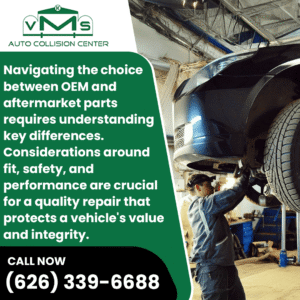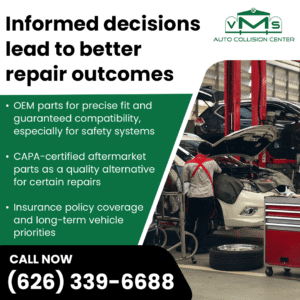Dent repair expenses vary based on multiple technical and procedural factors rather than simple size measurements. Vehicle owners in Covina often receive repair estimates that differ considerably from initial expectations due to hidden variables that surface during professional assessment. At VMS Auto Collision Center, our thorough evaluation process identifies specific elements that determine final pricing before work begins.
Vehicle damage presents unique characteristics that require different approaches. Repair professionals evaluate damage type, location, accessibility, paint system complexity, and required materials to determine appropriate methods. Each factor contributes to the overall scope and timeline of restoration work.

Primary Factors Affecting Dent Repair Expenses
Damage Size and Location
Dent size and depth determine the repair technique selection and associated expenses. Small surface depressions under two inches typically qualify for paintless dent repair (PDR) methods. Medium-sized damage measuring two to six inches may require hybrid approaches combining PDR with limited refinishing work.
Large deformations exceeding six inches often need traditional bodywork methods. These car dent repair situations involve metal reshaping, surface preparation, and paint system restoration. Deep impacts that stretch metal fibers beyond elastic recovery limits require more extensive restoration procedures.
Surface depth also affects repair complexity. Shallow dents maintain paint integrity and allow paintless reshaping techniques. Deep dents often crack paint surfaces, requiring refinishing procedures that add material and labor expenses.
Location accessibility affects repair complexity and time requirements. Door panels and accessible areas allow efficient tool positioning for PDR applications. Roof sections, pillars, and quarter panels present limited access challenges that require specialized equipment or panel removal procedures.
These assessment variables determine whether repairs require economical PDR methods or more expensive traditional bodywork approaches.
Paint System Complexity
Modern paint systems contain multiple layers that affect repair procedures and material requirements. Single-stage paint found on older vehicles involves basic color and protective elements in one application. These systems allow simpler repair procedures with fewer material components.
Multi-stage paint systems include primer layers, base color coats, and protective clear coat finishes. Each layer requires specific preparation, application, and curing procedures. Metallic and pearl finishes contain specialized particles that demand precise color matching and blending techniques.
Factory paint thickness varies between manufacturers and model years. Newer vehicles often feature thinner paint applications that limit the effectiveness of the PDR technique. Thicker paint systems from previous decades provide more flexibility for reshaping procedures without surface damage.
The complexity of paint layers and specialized finish requirements contributes to increased material expenses and extended labor timeframes.
Repair Method Selection Impact
Paintless Dent Repair Applications
PDR techniques offer the most economical approach for eligible damage situations. This method applies controlled pressure from behind damaged panels to restore original contours without disturbing paint systems. PDR requires intact paint surfaces and accessible panel backsides for proper tool positioning. Round dents with gradual edges respond best to PDR applications, keeping expenses minimal.
Sharp creases and linear damage often exceed PDR technique limitations, requiring more expensive alternatives. Large dents near body panel edges present challenges for traditional PDR approaches due to structural rigidity constraints. PDR eliminates material expenses for primer, paint, and clear coat applications. Labor time reductions make this approach more economical for eligible damage, reducing dent repair costs when compared to traditional methods. Original factory paint preservation maintains vehicle value better than refinished surfaces.
Traditional Bodywork Requirements
Paint damage or metal stretching beyond recovery limits requires traditional repair methods with higher material and labor expenses. These procedures involve multiple costly steps, including damage removal, surface preparation, primer application, color matching, and protective coating installation.
Material requirements include specialized primers designed for specific metal types, base coat materials that must match original factory formulations, and clear coat systems. Each material category adds to the overall car dent repair expense structure.
Traditional methods require controlled environment conditions for proper application, necessitating professional spray booth facilities. Temperature and humidity control equipment, extended curing times, and skilled technician requirements all contribute to higher dent repair costs compared to paintless alternatives.
Hidden Variables That Affect Repair Scope
Structural Integrity
Impact forces sometimes create expensive hidden damage beyond visible surface deformation. Professional inspection identifies potential structural issues, including bent reinforcement members, shifted panel alignment, and compromised weld points. These discoveries require immediate attention for safety compliance, often doubling original repair estimates when found during assessment.
Modern vehicle construction integrates high-strength steel in specific areas requiring specialized repair techniques and certified welding procedures. Structural repairs must meet manufacturer safety specifications using approved methods and materials, adding substantial labor and certification expenses to basic dent repair work.
Panel alignment affects door operation, window sealing, and aerodynamic performance. Misaligned panels create uneven gaps and potential water intrusion points, requiring precision measurement equipment and extended labor time. Professional restoration includes alignment verification using manufacturer specifications, which increases overall project expenses.
Electronic Component Integration
Current vehicle designs incorporate expensive sensors, cameras, and control modules within body panels that affect repair scope and expenses. Door panels contain window regulators, speaker systems, and electronic door handles requiring careful removal and reinstallation procedures. Component damage during repair work can add hundreds in replacement parts to basic car dent repair projects.
Advanced driver assistance systems (ADAS) often mount sensors behind body panels or within structural elements. Repair work affecting these areas may require system recalibration using specialized diagnostic equipment, costing additional labor hours. Calibration procedures add time and technical requirements that many shops may not be equipped to handle properly.
Wiring harnesses route through body cavities and door frames in complex patterns requiring careful inspection and protection during repair procedures. Wire damage or connector issues can affect multiple vehicle systems beyond the visible impact zone, creating cascading repair expenses that exceed original damage estimates.
Insurance Coverage Considerations
Policy Type
Comprehensive insurance covers weather-related damage with typically lower deductibles, reducing out-of-pocket expenses for vehicle owners. These claims apply to hail damage, tree branch impacts, and parking lot vandalism incidents without affecting collision claim history. Lower deductibles often make comprehensive claims more cost-effective for minor car dent repair situations. Understanding coverage types helps determine whether insurance claims provide a financial benefit over direct payment.
Claim Processing Impact on Expenses
Insurance claim approval timelines directly affect repair scheduling and associated expenses. Delayed approvals can extend rental car periods, increasing total claim expenses. Some shops may require upfront payment with later reimbursement, affecting immediate cash flow requirements. Preferred provider networks often negotiate lower labor rates with insurance companies, potentially reducing repair quality or extending completion timeframes. Independent shops may charge higher rates but provide faster service and superior materials, creating cost versus quality decisions for vehicle owners.
At VMS Auto Collision Center, we provide professional dent repairs near you with insurance assistance. Our experience with various insurance providers streamlines the claims process while protecting customer interests throughout repair procedures.
Vehicle Type and Age Considerations
Luxury Vehicle Requirements
Premium vehicles often require specialized materials, OEM parts, and certified repair facilities that increase dent repair costs considerably when compared to standard vehicles. European imports may need specific paint formulations or repair techniques unavailable at standard shops, requiring higher labor rates and premium materials. These requirements reflect manufacturer warranty conditions and resale value protection needs, but add substantial expense to basic car dent repair projects.
Luxury vehicle paint systems often feature multiple metallic layers, custom color formulations, or specialized protective coatings that require premium materials costing 2-3 times more than standard paint. Color matching requires advanced spectrophotometer equipment and experienced technicians familiar with premium paint systems, increasing both equipment and labor expenses.
OEM parts availability affects repair timelines and final restoration quality while adding significant material expenses to luxury vehicle repairs. Luxury manufacturers often specify exact replacement components to maintain structural integrity and appearance standards, with parts often costing double or triple aftermarket alternatives.
Classic and Vintage Restoration
Older vehicles present unique challenges, including discontinued paint colors, obsolete parts, and specialized knowledge requirements that can increase restoration expenses. Original paint formulations may contain materials no longer available due to environmental regulations, requiring custom formulation services that add substantial material and labor costs.
Color matching requires custom mixing and application techniques demanding specialized expertise that commands premium rates. Body panel access differs between vintage and modern designs, often requiring additional disassembly time that increases labor expenses. Older construction methods used different fastening systems and structural approaches requiring specialized tools and extended work hours. Repair techniques must accommodate original manufacturing methods while meeting current safety standards, adding complexity and associated costs.
Parts availability for classic vehicles often requires specialized suppliers or custom fabrication services that can multiply standard parts expenses. Original equipment may no longer exist, requiring careful reproduction or modification procedures that extend project timelines and increase overall dent repair cost substantially beyond modern vehicle repairs.
Avoiding Hidden Repair Costs with Professional Assessment
Professional damage assessment prevents costly surprises by identifying all repair requirements before work begins. Experienced technicians evaluate visible damage, check for hidden issues, and determine appropriate repair methods that establish accurate pricing from the start. This thorough evaluation prevents mid-project cost increases that can double original estimates when problems surface during amateur repairs.
Specialized equipment, including paint thickness gauges, metal measuring tools, and diagnostic scanners, provides precise damage evaluation that affects final pricing accuracy. These professional tools identify structural issues, paint damage, and electronic component problems not visible through basic inspection. This prevents expensive discoveries during repair work that increase dent repair costs unexpectedly.
Certification and Warranty Value Protection
Certified facilities maintain current knowledge of evolving vehicle technologies and proper repair procedures, preventing costly mistakes that require rework. This expertise translates into accurate initial estimates and first-time-right repairs that avoid additional expenses.
Professional repairs include written warranties that protect against future repair expenses and provide long-term cost security. Warranty coverage reflects the shop’s confidence in workmanship quality and eliminates potential costs for premature failure or substandard work. These warranties typically cover materials and labor for extended periods, providing financial protection that amateur or uncertified car dent repair services cannot offer.
Making Informed Repair Decisions
Timing Considerations
Early intervention prevents small issues from developing into larger problems. Surface dents can trap moisture and debris, leading to rust formation over time. Prompt professional assessment identifies all damage while repair options remain most favorable.
Weather-related damage requires immediate attention to prevent water intrusion. Hail impacts often create multiple small punctures that may not be immediately visible. Professional inspection identifies all affected areas for complete restoration.
Value Protection Strategies
Quality repairs maintain vehicle value better than temporary solutions. Professional work using proper materials and techniques preserves appearance and prevents future problems. Investment in quality repair work protects long-term vehicle value and reliability.
Multiple repair bundling can provide efficiency advantages when addressing several minor issues simultaneously. Hail damage situations often benefit from coordinated repair approaches that address all affected areas during single service appointments.
Professional shops providing dent repairs near you should offer detailed estimates that explain required procedures and expected outcomes. This transparency helps vehicle owners make informed decisions about repair approaches and understand value propositions.
VMS Auto Collision Center: Professional Dent Repair in Covina
Our I-CAR Gold Class certification and advanced equipment deliver superior results backed by lifetime warranty protection. We maintain current training in evolving repair technologies and safety procedures. Our systematic approach addresses all damage aspects while controlling the repair scope and timeline.
At VMS Auto Collision, we provide professional dent repairs near you with full insurance coordination, detailed assessments, and transparent communication throughout the repair process. Our experienced team works directly with adjusters to expedite approvals and minimize delays. This service eliminates stress while protecting customer interests.
Our modern repair facility with controlled environment conditions maintains consistent quality standards. Professional spray booth equipment and precision tools deliver results that meet manufacturer specifications. These investments translate into superior repair outcomes and customer satisfaction.
Get Your Professional Dent Repair Assessment Today
Contact VMS Auto Collision Center at (626) 339-6688 or info@vmsautocollision.com for a professional car dent repair assessment and discover why Covina area drivers trust us for superior dent repair.

